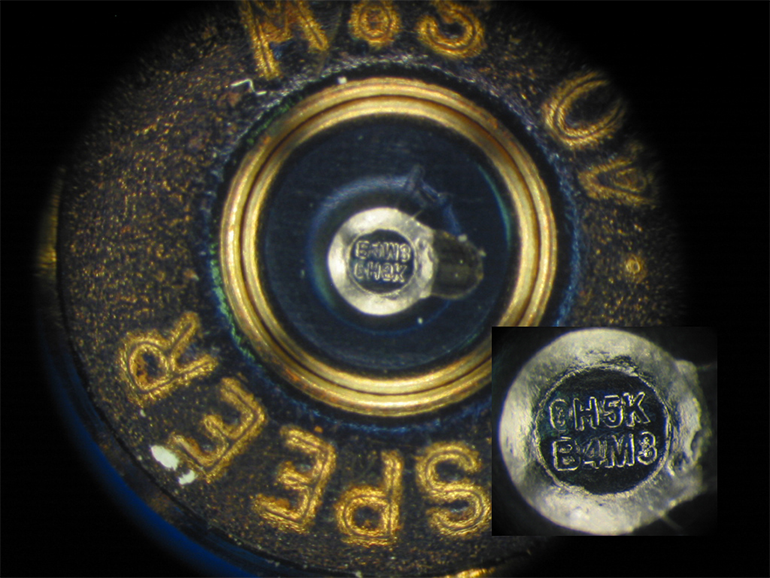
New Jersey’s Attorney General has finally reached a determination about the viability of firearm microstamping technology. The decision comes over a year late with wasted tax dollars to boot.
The state’s report only proved that the idea of microstamping is still severely flawed and not ready for implementation. The media attempted to sell the study, saying “gun ‘microstamping’ technology would make it easier for police to solve gun crimes” and that gun control activists call it a “game-changing technology.”
The Trace, hardly an “independent news outlet” and more appropriately described as billionaire gun control funder Michael Bloomberg’s gun control agitprop mouthpiece, admitted the evidence about microstamping is “mixed.” Interestingly, one of the cited sources in this study is now under the umbrella of Bloomberg’s Johns Hopkins Center for Gun Violence Solutions.
The firearm industry has always opposed mandates requiring firearm retailers to sacrifice shelf space to offer microstamping firearms and the New Jersey study – when thoroughly reviewed – demonstrates exactly why. It was a political document released by an anti-gun attorney general to satisfy a gun control law supported by a gun control-thirsty governor and nothing more.
The Results Are In
The microstamping viability study was part of a gun control legislative package that Gov. Phil Murphy signed into law in 2022. Bill A4368, required New Jersey Attorney General Matthew Platkin to determine if microstamping technology is “viable.” Not that technology is reliable or even somewhat consistent, but “viable.” Then the state could offer taxpayer-funded incentives to pressure firearm industry members to carry microstamping firearms on their shelves for customers. AG Platkin led the study and finally released it more than a year after its original statutory deadline.
To perform the state’s live-fire study, Platkin enrolled microstamping’s sole-source patent holder, Todd Lizotte. Lizotte, hardly an impartial participant, invented the technology in the 1990s and admitted his technology had considerable problems, stating in a 2012 AFTE Journal on microstamping, “Legitimate questions exist related to both the technical aspects, production costs, and database management associated with microstamping that should be addressed before wide scale implementation is legislatively mandated.”
To achieve “success” and show “viability,” Lizotte’s company administered a live-fire testing event at the New Jersey State Police Technology Center last year. The firearm used for the test was a 33-year-old 1911 style .45 ACP pistol. Lizotte said prior to the microstamping test the study pistol had only been fired about 1,800 times.
The .45 ACP predominantly utilizes a large pistol primer and has the greatest amount of surface area for a microstamping firing pin. These days, 9mm is king, and coincidently uses a small pistol primer. Suffice it to say using the larger primer for the test would give the microstamping test an edge with greater surface area.
For the test itself, an armorer fired fifty rounds at an indoor firing range. Ten of the fifty expended cartridge cases were designated for examination, including the first expended cartridge case, the fiftieth and the final eight from various intervals in between.
Only one of the ten fired cartridge cases delivered a full gear and alphanumeric code resulting in a failure rate of 90 percent for the chosen sample. In the end, nine out of 10 rounds sampled omitted critical portions of either the gear code, alphanumeric code, or both.
If the result omitted a single digit, that would mean one would have to potentially trace 10 firearms and, in turn, 10 suspects. If an alphabetic character were to be omitted, that means there are 26 guns to trace. If one number and one letter are omitted, you are getting into big numbers to trace.
That begs the question of how, then, do they reach the conclusion that reproducing 50 percent of the code and alphabetic characters is useful? At a minimum, 50 percent of an eight-character code with 36 combined objects results in 1.7 million unique combinations. And these were the results only after collecting 10 fired rounds. New Jersey’s AG created his own conclusion, regardless of the opposing factual results from his own study.
That was good enough for AG Platkin, though. “Based on these findings, and the Attorney General’s performance standards for microstamping technology in microstamping-enabled firearms, we recommend that the Attorney General certify that viable microstamping-enabled technology exists,” the report concluded.
Flawed Results
Fortunately, the viability study in New Jersey doesn’t mean the state now mandates firearm retailers to sell at least one microstamping firearm. The firearm industry is not opposed to the technology but is staunchly opposed to mandates requiring the firearms be offered. The technology isn’t reliable nor is it consistent.
The study, however, could very likely be the nudge needed in other states with similar laws that include mandates, like neighboring New York. New York passed a similar microstamping law as well in 2022 that requires a study “to determine viability” be completed before the state’s mandate can take effect. Predictably that process is several months behind schedule as well.
In New Jersey, one glaring sign demonstrates why even declaring microstamping “viable” is concerning and premature. The tested firearm only expended 50 rounds for the test. Even if you consider the other rounds that had allegedly been fired in the life of the gun tested (another 1,800 rounds), that is a very small testing sample on a firearm that should be fired much more than that. Fifty rounds is a fairly quick visit to the range for practice and sport shooters routinely fire hundreds of rounds in one range visit. What happens to the firing pin and the transferrable code after the gun is fired 5,000 times? Well-made pistols today can readily handle 10,000 rounds. How does the technology hold up after it has been used for 10 years?
The tested gun in the New Jersey study came from a firearm that was mostly in a lab or research and development facility. What happens to the firing pin code when the gun is used at an outdoor range and is dropped and gets dirty? All these variables affect how clearly the code is (or is not) transferred.
With the goal to prove viability the study neglected to explore how the technology can be defeated. In short, it is not only possible, but also cheap and does not require shooting the firearm. The firing pin can easily be filed or even replaced for a cost as little as $10. Criminals could also collect similar cartridge cases from a shooting range and disperse them at crime scenes to purposely thwart authorities and waste precious law enforcement resources.
The Reviews Are In
Microstamping technology has now been around for nearly 25 years and a key theme is nearly always present in studies about the technology’s use – it’s not ready for primetime. This is why microstamping should never be mandated for commercial use or for retailers to carry on the shelves. When California attempted to do just that, its microstamping mandate was struck down in federal court.
The National Academy of Science Study looked at microstamping and recognized the flaws. “Further studies are needed on the durability of microstamping marks under various firing conditions and their susceptibility to tampering, as well as on their cost impact for manufacturers and consumers,” their report said.
“Implementing this technology will be much more complicated than burning a serial number on a few parts and dropping them into firearms being manufactured,” said George Krivosta, a professor with the professional scholarly journal for forensic firearms examiners.
“At the current time it is not recommended that a mandate for implementation of this technology be made. Further testing, analysis and evaluation is required,” is what researchers at the University of California at Davis – hardly a bastion of gun rights proponents – said of microstamping.
The bottom line is microstamping does not work. Lizotte himself agreed that alphanumeric codes are often illegible under even perfect conditions, as was shown in the New Jersey test. Even under perfect conditions, retrieving 10 spent cartridges resulted in only one casing producing a fully intact code.
Other gun control states watching New Jersey release their “viability study” should instead read more independent research on microstamping, or better yet – visit a shooting range for some firsthand experience.
Larry Keane is SVP for Government and Public Affairs, Assistant Secretary and General Counsel of the National Shooting Sports Foundation.


Micro stamping works great as a gatekeeping measure.
I don’t recall microstamping requirement laws in the founding era of our nation…
Do you?
90% failure rate. That is far better performance that New Jerseyans get from their State government.
As I’ve said before, this entire microstamping idea is pie-in-the-sky wishful thinking. This has absolutely *NO* effect on revolvers or shotguns. And criminals could simply scoop up scattered semi-auto ejected brass off the ground at any gun range and use those to “salt” future crime scenes to throw the cops off the trail. Furthermore, how many people would be taking a dremel to their firing pins to obscure a couple of the pin’s characters and render them useless for forensics?
The entire thing smacks of nothing more than a Democrat talking point, so politicians and the tyrants pulling their strings can tell the masses they’re “doing something about the gun v!olence”.
Utter nonsense.
Here, here!!!
These fuckin people are so stupid. Criminals aren’t going to use those guns to murder.